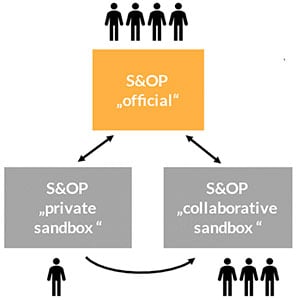Navigating Uncertainty: Tech-Driven Scenario Planning
Ute Strohmaier - December 12, 2023

In the dynamic landscape of today's business world, embracing digital transformation is not merely an option but a strategic imperative. Companies striving for resilience and competitiveness are turning to advanced technologies, and one such game-changer is the integration of Big Data into Sales and Operations Planning (S&OP). This paradigm shift empowers organizations to not only adapt to unpredictability but to proactively plan for multiple scenarios. At the heart of this transformation lies the ability to leverage historical data, conduct sophisticated simulations, and engage in what-if analyses to chart a course through uncertainty.
Data is Everything
To embark on this journey, companies must recognize that data is the linchpin of effective S&OP solutions. It's not just about collecting vast amounts of information; it's about curating, annotating, and understanding the data's context. Historical data, when properly harnessed, becomes the fuel for Artificial Intelligence (AI) and advanced analytics, allowing businesses to make informed decisions.
Moreover, the scope of data isn't confined within organizational boundaries. Third-party data, sourced from within the industry, can enrich analytics, providing a broader perspective for more accurate predictions. The success of AI applications is intricately tied to the synergy between the right data and the right algorithms. The mantra is clear: intentional data collection, annotation, and storage lay the foundation for robust AI applications.
Continuous improvement is another crucial aspect. The iterative process of feeding data into solutions ensures ongoing refinement, enhancing the accuracy of predictions and the efficacy of S&OP planning over time.
Scenario Planning
Scenario Planning emerges as a key facet of S&OP, offering a strategic advantage in navigating uncertainties. Consider the use case of Demand Capacity Planning, where tools like the flexis DCM Module come to the forefront.
This module seamlessly integrates with various Bill of Materials (BOMs), allowing planners to apply them at different levels within the supply network. Modeling sourcing strategies, incorporating real-world factors like resource utilization and pass rates, ensures a comprehensive understanding of demand and capacity dynamics.
The concept of Rückrechnung (Reverse Calculation) adds another layer of sophistication, enabling planners to factor in lower-level restrictions on higher planning levels. This level of granularity in planning ensures a nuanced approach, accounting for diverse scenarios and mitigating risks effectively.
Scenario Planning, Simulations, What-if-Analysis
A pivotal tool in this arsenal is the Sandbox—a complete replica of the official S&OP version, equipped for simulations and what-if analyses. The sandbox operates in two modes: private (for single-user exploration) and collaborative (for team-based experimentation).

This sandbox environment allows for the modification of planning parameters without disrupting ongoing operations. Data is seamlessly transferred between the official version and sandboxes, ensuring that planners can explore alternatives without affecting the current business flow. Conflicts are monitored, and a delta report facilitates a granular comparison of data between instances.
Roles and privileges play a crucial role in collaborative S&OP. Opening up access allows, for instance, a logistics planner to modify sales and production numbers, fostering collaboration across different functional domains.
In essence, collaborative S&OP with Sandboxes and Simulations empowers organizations to test and refine different versions of plans, fostering adaptability and agility in the face of evolving circumstances.
Conclusion
In an era of constant change, the combination of historical company data and 3rd-party data in the S&OP process with integrated scenario planning is proving to be an important building block for more resilience for future-oriented companies. The integration of historical data, sophisticated modeling techniques, and collaborative sandbox environments propels organizations into a realm where they can not only adapt to change but strategically plan for it.
In the tech-driven landscape of S&OP, the ability to simulate, analyze, and iterate through scenarios is a competitive advantage. It transforms uncertainties into opportunities, making businesses not just reactive but proactive in their approach. The future belongs to those who can harness the power of Data to illuminate the path forward, turning unpredictability into a canvas for strategic innovation.
If you want to learn more, download your guide to Transformation of Manufacturing Processes.
In this Guide you will learn:
-
Emerging Challenges in the Modern Truck/Automotive Industry
-
How Can Global Companies Adapt to These New Realities
-
How Decentralized Digital Systems Power Smarter Planning Processes
-
How flexis Can Support Flexible Supply Chain Transformation
LATEST POSTS
- Understand Why Production Planning Needs Specialized Solutions
- Understand Circular Economy in The Manufacturing Industry
- How Can Industry 4.0 IT Integration Be Achieved Smoothly?
- The Significance of Order Sequencing in Discrete Manufacturing
- How to improve your Supply Chain Management: The Power of Control Towers



